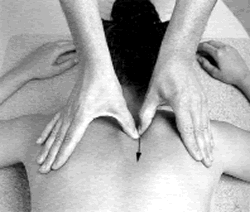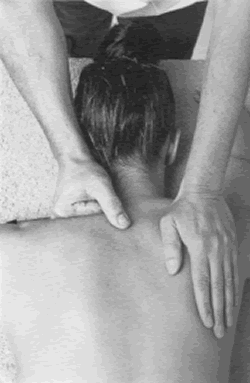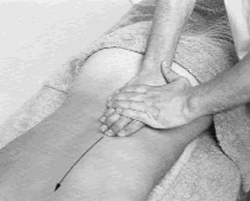Positive Health Online
Your Country

The Importance of Good Posture in Bodywork Part II
by Mario-Paul Cassar(more info)
listed in bodywork, originally published in issue 113 - July 2005
Following on from my previous article (Issue 109, March 2005) on the subject of posture in massage and bodywork, I will now focus on the use of the hands, the thumbs and the forearm. Their correct application is as important as the standing posture for the practitioner, and indeed very much part of the overall movement.
The palm and fingers can be seen as the fundamental tools for the palpatory skills that are essential to massage and bodywork. They are used to 'read' the tissues, to sense the irregularities in the tissues, such as tension, tightness, fibrosis, oedema and adhesions. Of equal importance, the hands detect the changes that occur as a result of the technique being applied. Palpation and assessment of the tissues is, therefore, most effective when the hands are relaxed.
Perhaps the most significant benefit of massage is that of relaxation. This is achieved not only with the correct pressure and rhythm of the stroke but also when the hands are very relaxed. Any tension in the therapist's hands may reflect anxiety, which can easily be transferred to the recipient and eradicate any attempt to induce relaxation. Accurate use of the hands, thumbs or forearms is also needed to improve circulation, treat fibrotic tissue, adhesions and so forth.
A frequently overlooked reason for maintaining a good posture and using the hands specifically during massage and bodywork is that of safety, not only for the patient, which is an understandable requirement, but also for the practitioner. He/she may be too keen to demonstrate their techniques to a patient. They may carry on working even when tired, or wrongly assume that heavy pressure is needed for the massage to be effective. Their movements may be too fast and without a suitable rhythm. These are typical practices which result in the practitioner becoming susceptible to repetitive strain injuries (RSI) and joint problems. Preventative measures, such as the ones I include here, must therefore be taken in order to avoid such impairments.
Pressure for the massage stroke is predominantly exerted by the weight of the body and not with the hands, and muscle contractions of the hand are therefore minimized. Particular attention is needed when using the thumbs. Extending the distal interphalangeal joint when applying pressure with the thumb exerts a great deal of stress on the joint itself and can lead to pain and degeneration. It is, therefore, advisable to always keep the thumb straight or in a slightly flexed position, particularly when applying neuromuscular technique (Figure 1).

Figure 1: Neuromuscular technique on the muscles and fascia of the upper neck
Rather than using one hand to apply heavy pressure both hands can be used, placed one on top of the other. A fisted hand as in effleurage du poing is also a safe method of applying a heavier effleurage movement (Figure 2).

Figure 2: Effleurage du poing on the neck and shoulder

Figure 3: Deep effleurage to the lower and upper back using reinforced hands
Effleurage with the forearm, in particular, can also be used when heavy pressure is required to increase the local circulation (Figure 3). Theoretically, it can be applied on most regions of the body. It is advisable, however, that the head, chest and abdomen be avoided at all times and the technique restricted to the back, legs and arms. Whilst massage with the forearm can be used to avoid a strain on the hands it does not provide the same precise contact with the tissues that the fingers and palms can offer. Sensory receptors in the palmar surface of the hands far outnumber the ones on the forearms. For the assessment of tissue dysfunction, therefore, the hands are better tools. A further word of caution about the use of the forearm as a 'massage tool', whilst massage with the forearm can indeed avoid the use of the fingers and subsequently any strains of the wrists and the hands, the technique itself cannot be considered entirely safe when practised exclusively for the whole body. Repetitive strain of the shoulder girdle, as well as that of the elbow, can result from overuse of the forearm effleurage, particularly if consistent body weight is applied at the same time.
In conclusion, it is worth bearing in mind that a combination and variation of massage movements is the best approach of ensuring a safe and effective treatment. Different tissue states are necessarily treated with the most suitable 'tool', whether this be the thumbs, the palms of the hands, the fisted hand, the forearm or indeed the lightest of touches.
Comments:
-
No Article Comments available